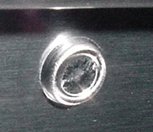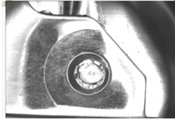A Machine Vision Approach for Tox Joint Inspection
In today’s modern manufacturing environment there is a wide variety of sheet metal joining applications. One such technique uses what is known as a tox joint. A joint is formed using a round punch that presses the 2 materials to be joined into a die cavity. A good quality joint requires the tooling be in good shape and have proper alignment between the punch and die.
Decision Technology has developed a set of machine vision tools to inspect the final punched joint. Along with this are several optical configurations based on space constraints and associated accessibility to the joint. These tools along with proper lighting can be used to reliably make a pass/fail judgment in regard to the quality of the punched joint, generally a function of tool condition or alignment.

We’ve found that with the proper lighting there is an abundance of information that can be extracted. In the preprocessed images as shown below, there are several governing features that can be extracted and used for judgment. Such features include:
- In regard to each ring of the double rings we have extracted there is:
- Area, roundness, ring width symmetry
- Additionally we have extracted information in regard to:
- Concentricity of the rings
- Internal surface contamination
The initial set of processing algorithms have proven to do quite well at processing and determining judgment factors for these and other typical images.


